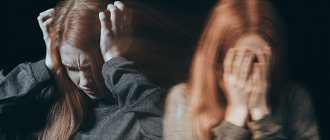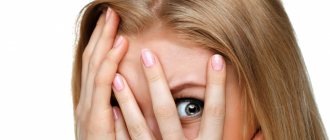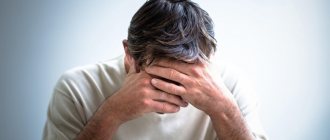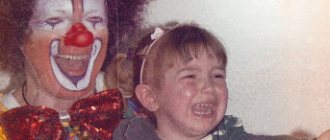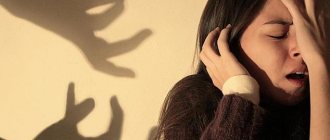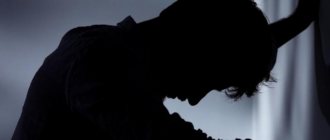The human community is a huge collective, in which changes in internal and external factors often lead to stress and overwork in individuals. The gradual accumulation of problems can become the root cause of the development of a feeling of fear, the essence of which is difficult to determine. Sometimes anxiety is a consequence of the appearance of the first symptoms of some chronic disease, in which case anxiety is classified as a side effect that will disappear after recovery.
Anxiety-phobic disorder is characterized by doctors and patients as rebellious, restless, and often patients, not understanding where the trouble is coming from, begin to commit rash and wild actions, aggravating their situation. Sometimes, without qualified, timely help, a person begins to think about suicide. In many patients, restlessness and anxiety are accompanied by disturbances in the functioning of the gastrointestinal tract, dizziness, profuse sweating, increased blood pressure and heart rate, and often sharp jumps in sugar readings. To define this condition, psychologists and psychiatrists use the term frustration.
At CELT you can get advice from a psychiatrist.
- Appointment with a psychiatrist with an extended interview, psychotherapy session - 4,700
Make an appointment
Anxiety and its causes
Healthy people often feel anxious when exposed to many external factors. Anxiety during an exam, when family problems arise, an unexpected change in your usual lifestyle, or troubles at work can cause psychological stress and will quickly disappear once the difficult situation is resolved. However, there is a psychotype of people who are in a constant state of anxiety, regardless of external influences, or who react much more strongly to ordinary everyday troubles, falling into nervousness.
If you believe scientists, then such a symptom is inherited at the genetic level and can subsequently be clearly expressed in the case of improperly constructed intra-family relationships. In addition, psychologists argue that inflated self-esteem, which runs counter to a person’s real capabilities, is often the first step that creates anxiety. The sooner a person realizes the impending danger and begins effective treatment, the easier and faster the disease can be dealt with.
Course of obsessive-phobic neurosis
There are several variants of the course of anxiety-phobic disorder:
1) attacks of panic attacks, as a rule, are not accompanied by manifestations of other phobias;
2) a combination of panic attacks and persistent agoraphobia, while in the manifestation of panic attacks, strong fear prevails over the physical manifestations of the phobia. A person can take extreme measures (a complete change of activity, moving, changing contacts) to level out the possibility of new panic attacks;
3) vegetative manifestations of panic attacks prevail over the severity of fear and subsequently provoke attacks of hypochondriacal phobias.
Diseases that can lead to anxiety
Many doctors encountered in their patients the manifestation of an unmotivated feeling of anxiety, which defied logic and did not give patients the opportunity to lead a full life. Often the root cause was the following diseases:
- Disruption of the normal functioning of the thyroid gland.
- Difficult menopause in women.
- Loss of sexual desire in men.
- Some infectious diseases.
- Pre-infarction condition.
- Malfunctions of the endocrine system.
- A sharp increase in blood sugar levels.
- Most mental illnesses are accompanied by feelings of anxiety.
- People with schizophrenia often become more restless during periods of exacerbation.
- With neuroses, feelings of anxiety can grow like an avalanche.
- Patients with alcohol or drug addiction, as well as those suffering from “non-chemical addictions” (shopaholism, gambling addiction, Internet addiction) experience a pronounced feeling of anxiety during withdrawal symptoms.
Many people in an anxious state complain of the appearance of hallucinations, partial or complete loss of sleep, their mood inexorably deteriorates, aggressiveness and irritability appear, often unrelated to the events taking place around the person.
Symptoms of the disease
Symptoms of anxiety-phobic disorder include:
- Panic attacks are a sudden strong fear of danger, death, causing autonomic disorders in the patient: dizziness, fainting, nausea, lack of air, tachycardia.
- Agoraphobia – fear of public places, crowds, the street.
- Hypochondriacal phobias are fear of the possibility of illness, intense search for symptoms, panic and confidence in the inevitability of illness at the slightest detection.
- Social phobias – fear of being evaluated by other people, fear of close attention from others.
- Other phobias: fear of heights, touching, confined spaces, elements, certain situations.
For a person prone to phobias to manifest them, it is enough to remember and imagine similar situations or a previous attack. Phobias tend to develop: embarrassment during speeches in front of the public or management, with the aggravation of obsessive states, is transformed into a fear of ordinary communication with well-known people.
Which doctor will help you cope with anxiety?
Whatever the reasons for the appearance and development of a phobia, you should consult a doctor as soon as possible so that the disease does not get out of control and lead to serious consequences. If anxiety does not go away within several days, and you cannot determine the cause of the condition, do not delay visiting the doctor. Treatment will be much more effective if the specialist has sufficient practical experience and good specialized medical education. If necessary, take all the tests and undergo a full examination, this will help you get a more complete picture and make treatment more productive and faster.
If necessary, the therapist can refer the patient for consultation to specialists. An endocrinologist or neurologist, cardiologist or psychotherapist will be able to conduct a full examination and identify the root cause of anxiety. Often, effective treatment of chronic diseases automatically leads to a change in psychosomatic state. If no chronic diseases are identified, and the person complains of hallucinations and an anxious decline in mood, it is necessary to seek help from a psychiatrist. If feelings of anxiety lead to loss of consciousness or strange tremors appear in the limbs, a visit to the doctor cannot be postponed. If the symptoms grow like an avalanche and are accompanied by pronounced pain, convulsions, and sudden surges in pressure, it is better to call a doctor at home. Remember that anxiety often leads people to commit suicide because their mental state becomes unbearable.
Phobic disorders
Common symptoms of phobic disorders are intense acute fear when confronted with the object of the phobia, avoidance, anticipatory anxiety, and awareness of the irrationality of one's own fear. Fear upon contact with an object provokes some narrowing of consciousness and is usually accompanied by violent vegetative reactions. A patient with a phobic disorder completely focuses on the frightening object, to one degree or another ceases to monitor the environment and partially loses control over his own behavior. Increased breathing, increased sweating, dizziness, weakness in the legs, palpitations and other vegetative symptoms are possible.
The first encounters with the object of a phobic disorder provoke a panic attack. Subsequently, the fear worsens, exhausts the patient, and interferes with his normal existence. In an effort to eliminate unpleasant sensations and make life more acceptable, a patient with a phobic disorder begins to avoid frightening situations. Subsequently, avoidance is reinforced and becomes a habitual pattern of behavior. Panic attacks stop, but the reason for their cessation is not the disappearance of the phobic disorder, but the lack of contact with the object.
Anticipation anxiety is manifested by fear when imagining a frightening object or realizing the need to get into a situation of contact with this object. Erased vegetative reactions arise, thoughts appear about intolerance to such a situation; a patient suffering from a phobic disorder plans actions to prevent contact. For example, a patient with agoraphobia, if necessary to visit a large shopping center, thinks through alternative options (visiting small stores selling similar goods); a patient with claustrophobia, before visiting an office located on the upper floors of a building, finds out whether there are stairs in this building that can be used instead elevator, etc.
Patients with phobic disorders are aware of the irrationality of their own fears, but ordinary rational arguments (their own and those of others) do not influence the perception of a frightening object or situation. Some patients, forced to regularly be in frightening situations, begin to take alcohol or sedatives. With phobic disorders, the risk of developing alcoholism, dependence on tranquilizers and other drugs increases. Debilitating fear and restrictions in social, professional and personal life often provoke depression. In addition, phobic disorders are often combined with generalized anxiety disorder and obsessive-compulsive disorder.
Phobia - from the Greek word fear, fear. In psychiatry, phobic disorders are those associated with the experience of fear in relation to any objects, movements, actions, behavior, situations and even people; The content of a phobia can be any phenomenon of everyday life.
Not all fears are phobias
However, not in all cases the presence of fear can be attributed to a phobia and mental disorder. For example, if you are afraid to drive a car or afraid of speaking in public, then this is not always necessarily a phobia. Such fears may be associated with feelings of self-doubt, lack of skills, or personality traits such as general increased anxiety. In addition, anxiety and fear in themselves have a positive meaning. For example, when you cross the road, your anxiety level naturally increases. The body and psyche need this in order to increase attentiveness and overall tone, allowing you to quickly react to a situation of increased danger. This mechanism is laid down at the subcortical level and works automatically, practically without the participation of consciousness.
What are the types of anxiety-phobic experiences?
True phobias are obsessive, emotionally charged and intense. The experience of such fear is always associated with avoidance of meeting the object or situation that causes it. Often a person cannot explain to himself or others why he is afraid of this phenomenon or object. The source of painful experiences is in the realm of the unconscious. In the process of psychotherapy for anxiety-phobic disorder, it is necessary to analyze anamnestic data and all available information about the patient, use the method of associations, projective techniques and other psychological techniques to find and eliminate the cause.
Phobias such as, for example, arachnophobia (fear of spiders), lysophobia (fear of madness), nyctophobia (fear of the dark) and so on, the list can be very long, are called simple phobias. There are phobias related to social functioning. They are called social. In their structure is the fear of being in the center of people's attention and looking awkward. At such moments, people feel awkward, ashamed, afraid that everyone is paying attention to them.
There are also phobias when the patient himself initially understands and easily voices to the specialist the psychogenic reasons for their occurrence. When any traumatic event, for example, a car accident or a sudden deterioration in a physical condition, leads to the formation of fears and phobias.
Agoraphobia
Agoraphobia is the fear of open spaces. A very common disorder. Often accompanied by panic attacks, fear of loss of control, heart attack or other physical catastrophe, fear that no one will come to help. Agoraphobia is often combined with claustrophobia - the fear of being in a confined space, of not being able to leave - and manifests itself in the form of panic attacks.
Psychotherapy for anxiety-phobic disorders
People suffering from anxiety-phobic disorders clearly need psychological and psychotherapeutic help. A course of psychotherapy can permanently relieve existing fears, and in clinically complex cases, it can significantly reduce the intensity of painful experiences.
If this problem is left unattended, the condition may worsen, becoming chronic or generalized, i.e. expansion of manifestations of phobias. Psychiatrists and psychotherapists use this term to describe the process when the number of phobias grows, including all new phenomena and events. If previously agoraphobia manifested itself only in large areas, then when generalized, a person has difficulty leaving the house, and this will lead to artificial social isolation and other problems.
In the treatment of anxiety-phobic disorders, such types of psychotherapy as cognitive-behavioral, psychodynamic, and hypnotherapy have proven themselves well.
Diagnosis of an anxiety disorder
The presence of the above symptoms does not yet indicate the disease. The diagnosis must be made by a psychiatrist, and in order for the specialist to recognize the problem and confirm the presence of the disease, the symptoms of anxiety disorders must bother the patient for at least 2-3 weeks.
Anxiety disorders diagnose . But identifying the type of anxiety disorder is quite problematic. The reason for this is similar symptoms in different types of disease. Its type and degree can be identified by analyzing the places and times of occurrence of symptoms. In general, in diagnosing anxiety disorders, the depression and anxiety scale, the Spielberger-Hanin test, the personality anxiety scale, and many others are used.
If you suspect an anxiety disorder, you need to gather yourself, adequately assess the situation and try to answer several questions for yourself:
- Are there feelings of fear and anxiety, problems with autonomic regulation and sleep disturbances;
- How long have the symptoms continued to bother you?
- Can the symptoms be associated with organic diseases? It is better to visit a doctor and check your health;
- Is there any systematicity in the appearance of symptoms (they happen in a certain place, under certain conditions, at a specific time, and so on).
Who is most susceptible to developing phobic neurosis and for what reasons?
This ailment can develop both as an independent disease against the background of existing specific character traits and temperamental characteristics, and as a complication of existing diseases - psychopathy, psychasthenia, alcoholism, drug addiction. Neurosis with fears can aggravate the course of diseases of internal organs (myocardial infarctions, strokes), oncological processes, endocrine pathologies. Both men and women are susceptible to phobic neurosis. The primary development of symptoms of the disease is characteristic of adolescence, as well as the transitional stage from maturity to old age. You can often observe phobias in women during menopause.
People's fears develop against the background of:
- chronic psychophysical fatigue and overstrain;
- received mental trauma;
- any long-term, debilitating disease;
- regular lack of sleep and poor nutrition;
Causes of Anxiety Disorder
The causes of anxiety disorders are explained by several theories from a biological and psychological point of view.
Biological theories. According to these theories, the disease is explained as a kind of biological anomaly caused by certain changes in the body. The most popular version of the occurrence of anxiety disorders is an increase in the production of neurotransmitters.
We should not exclude the possibility that it is the locus coeruleus that is responsible for the symptoms of the disease. It is located in the brain, namely in the stem part of it, and with electrical stimulation it becomes the cause of anxiety and fear. Medications that reduce the activity of the locus coeruleus and therefore reduce anxiety include propranolol, clonidine, and benzodiazepines. In turn, medications like yohimbine increase anxiety.
Psychological theories. From the point of view of psychoanalysis, anxiety is a manifestation that signals the presence of a forbidden need or a certain impulse that needs to be hidden and prevented from expressing the need. According to this theory, the symptoms of anxiety disorders are explained as containing an unacceptable need within oneself.
Phobias and anxieties in general, from the point of view of behaviorism, are considered as a reflex reaction to the sudden or expected appearance of frightening or painful stimuli. The brain gets used to this reaction and soon anxiety begins to arise regardless of whether there is a stimulus or not.
More recently, cognitive psychology has emphasized erroneous and distorted mental patterns that precede the onset of anxiety symptoms. For example, with anxiety disorders, patients may react in panic to seemingly standard sensations and ailments in everyday life (palpitations, mild headache). As a result, fear intensifies, and over time it grows and leads to a powerful panic attack. In domestic medicine, anxiety disorders are classified as a group of functional neuroses (a more modern name is neurotic disorders). According to the traditional classification, the disease is classified as psychogenic, which is characterized by awareness of the disease, a variety of symptoms and manifestations, as well as a complete absence of changes in consciousness.




